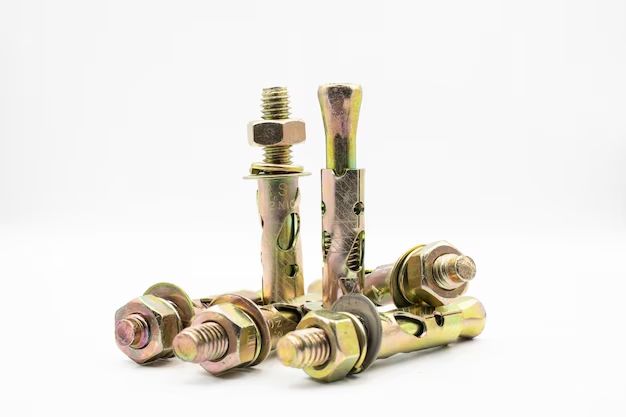Using expansion bolts, also known as wedge anchors, is an effective way to secure objects to concrete. Expansion bolts work by wedging themselves into a drilled hole in the concrete as the bolt is tightened. This creates a strong hold that can support substantial weight. Understanding when and how to use expansion bolts properly is key to creating a safe and secure connection.
Page Contents
When should you use expansion bolts?
Expansion bolts are ideal when you need to:
- Attach objects to solid concrete surfaces like floors, walls, and ceilings
- Support heavy loads like shelves, machinery, or structural framing
- Create a detachable connection that can be removed and reinstalled if needed
The wedge design allows expansion bolts to grip firmly in concrete thicknesses between 2-1/4 and 6 inches. They should not be used in brick or hollow tile. Expansion bolts are not suitable for outdoor use in locations exposed to freezing weather.
Choosing the right size expansion bolt
Expansion bolts are available in different diameters and lengths to accommodate various load capacities and concrete thicknesses. The steps for selecting the right size include:
- Determine the load – Consider the total weight load including the object being fastened and any additional dynamic or vibration loads.
- Check the concrete thickness – The depth the bolt will embed in the concrete impacts pullout strength.
- Consult load/thickness tables – Match the required load capacity and material thickness to select the bolt diameter and length.
- Consider edge distances – Ensure enough distance from concrete edges and other bolts.
Using bolts that are too small or anchors that don’t penetrate deep enough can lead to failure. When in doubt, choose a larger size bolt or consult an engineer.
Tools and materials needed
Installing expansion bolts properly requires using the right tools. You will need:
- Hammer drill – For drilling anchor holes in concrete.
- SDS masonry drill bits – Match bit size to bolt diameter.
- Impact wrench – Power tool for driving anchors quickly (optional).
- Torque wrench – For tightening anchors to the specified torque value.
- Vacuum – For cleaning concrete dust from anchor holes.
- Tape measure – For laying out spacing and measuring depth.
- Concrete expansion anchors – Properly sized wedge anchor bolts.
- Steel fixtures – Base materials like equipment, beams, plates.
Having the right PPE like eye protection, gloves, and hearing protection is also important when drilling and installing anchors.
Installation steps
The process for installing expansion bolts in concrete involves six main steps:
- Mark hole locations – Use a tape measure and marker to lay out the desired mounting position and mark bolt hole centers.
- Drill anchor holes – Use a hammer drill and masonry bit sized for the bolt diameter to drill straight, cylindrical holes to the recommended depth.
- Clean holes – Use compressed air or a vacuum to remove all drilling dust and debris from the holes.
- Place anchors – Insert the expansion anchor fully into the hole until the head contacts the base material surface.
- Tighten bolts – Turn the bolt slowly until the wedge segments contact the hole walls, then tighten to the specified torque value.
- Attach fixtures – Place the equipment, plates, or other items over the anchor bolts and use washers and nuts to complete the attachment.
Pay close attention to manufacturer instructions for tightening torque values and proper use. Overtightening can damage the anchors.
Tips for use
Here are some helpful tips to get the best results from expansion anchors:
- Always use sleeve anchors for attaching to concrete that is pre-cracked or may be subject to future cracking. The sleeves prevent cracking caused by point stresses.
- For heavy duty loads, use reinforcement around the anchors. Adding rebar dowels around bolts boosts shear strength.
- When drilling overhead, use commercially available depth locators to ensure the right embedment depth is achieved.
- For wedge anchors under vibration or shock loads, retighten the anchors after 2-4 weeks to maintain proper preload on the bolt.
- Use galvanized or otherwise protected anchors for outdoor concrete applications to avoid corrosion issues.
- Start all anchors by hand before using an impact wrench to avoid cross threading or overtightening damage.
Removing expansion bolts
To remove an expansion bolt, use the following steps:
- Loosen the nut several turns to relieve the tension on the bolt.
- Use an impact wrench or box wrench to back the bolt out several revolutions.
- For stubborn anchors, use a punch and hammer to help break the wedges free and back the bolt out.
- Inspect the hole after removal and clean thoroughly before installing a new bolt.
Avoid drilling out expansion bolts unless absolutely necessary, as this can crack the concrete.
Conclusion
Expansion anchors provide a versatile, heavy duty fastening option for securing objects to concrete. Following proper selection, drilling, installation, torqueing, and inspection guidelines allows the anchors to create a safe and long-lasting attachment. With the right techniques, expansion bolts are an easy-to-use fastener for both DIYers and construction professionals.
